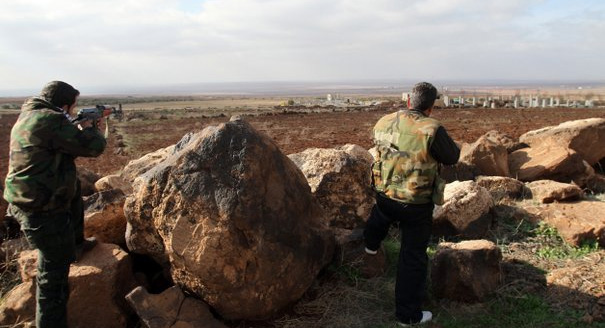Deraa, the cradle of the Syrian uprising, is a peculiar battleground—a low, flat area of fields and plains jammed inbetween the Israeli-occupied Golan Heights and the Arab Mountain, home to Syria’s Druze minority. It makes up most of the Houran, an ancient agricultural region whose Sunni Arab Muslim population—there are a few Christians as well—is united by a strong regional identity.
The tightly knit clans of the Houran region are in fact inextricably entangled with those of northern Jordan, to the consternation of King Abdullah II—and the international complications do not end there. To the west, Israeli forces are peering, and occasionally firing, across the 1973 ceasefire line. To the east, Syria’s Druze community balances on a fine line between neutrality and support for Assad, with local activists eager to stave off the threat of a sectarian strife that would have ripple effects as far away as Lebanon.
It is this region, Deraa, which has become the main point of entry for direct U.S. support to the Syrian insurgency. President Obama ordered U.S. troops to Jordan already in 2012, and there have long been reports of rebel forces being trained by Americans in Jordan. U.S. involvement in Jordan seems to be growing steadily, and Obama reportedly acknowledged—for the first time—that a group of ”officially” CIA-trained rebels had entered Syria in August or September 2013.
Differing Views of Deraa’s Insurgency
The southern rebellion is in some ways a different beast from the much larger and more chaotic northern front, stretching from the Mediterranean coast to the Iraqi border. Some portray Deraa as the Syrian revolution’s “secular corner,” arguing that the influence of tribal politics and direct foreign sponsorship across the Jordanian border has empowered moderate Islamist and nationalist forces. But the insurgency remains very divided even in Deraa, and others take a more sanguine view, saying that southern Syria is not fundamentally different from the north.
In April this year, Jonathan Dupree of the Institute for the Study of War, published a survey of the conflict in southern Syria. It was written after a series of opposition advances in the Deraa-Golan region, on the heels of rebel consolidation under Brig. Gen. Salim Idriss and a concurrent spike in weapons deliveries. During winter and spring, Saudi Arabia and other states ran guns from Croatia to Jordan, and from there, on to their favorite factions in southern Syria.
However, from about May onwards, it became clear that the southern front had bogged down—partly because guns had dried up. According to some, the US had intervened to temporarily stop or slow deliveries, after it became apparent that the Croatian weapons intended for ”vetted” rebel units were sliding into the hands of Jabhat al-Nusra, an al-Qaeda faction. Simultaneously, the regime made gains in the Damascus and Homs regions, further blunting the narrative of opposition advances.
However, the reports of Assad “winning the war” were just as exaggerated as earlier claims that the regime was on its last legs. By late summer, fighting raged on in Deraa and rebels had begun to claw back territory. In August, Michael Weiss published two interesting articles ("The Southern Front Part I" & Part II) on the state of the southern front, arguing that ”in stark contrast with northern Syria,” it had seen ”moderate, Western-and-Arab-backed rebel formations performing exceptionally well not only against the regime but also in competition with Salafist-jihadist elements.”
But again, the tide is slowly shifting and others would make the opposite point. In mid-October, as fighting intensified, Kirk H. Sowell presented a more somber analysis. Sowell argued that it was the hardline Islamist groups that seemed to gain most from the fighting in southern Deraa and that they are at forefront of most offensives. In Sowell’s view, “Jabhat al-Nusra’s preeminence in Daraa operations is clear now.” By contrast, the Idriss-aligned factions of the Deraa Military Council, which appear to be under the influence of Jordanian intelligence, “do not appear to be doing much.”
The course of the war in Deraa will no doubt continue to twist and turn, responding to international realignments as well as its own internal dynamics, but it is a front much worth watching. The United States, Saudi Arabia, Jordan, and other international powers are heavily invested in the battle for Syria’s south, and Deraa has become a springboard not only for opposition advances into the Golan Heights and the Sweida Province, but also towards Damascus itself.






